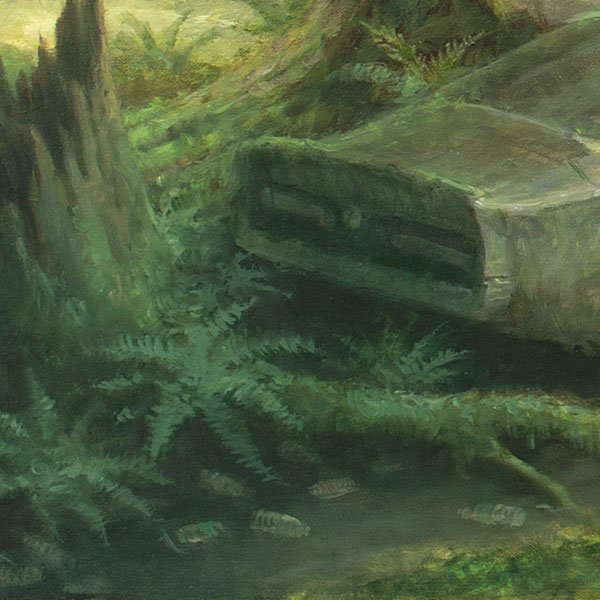Creating a painting is like exploring a maze. You never know where the creative process will lead you. As a painting evolves, you encounter many twists and turns. And if you come upon a dead end (which is when a painting is simply not working), rather than despair and give up, you just retrace your steps and pursue a new direction. The interesting thing about staying flexible like this is you can sometimes find yourself creating a much better painting than you expected. Here’s a story about the creation of my painting “The Oil Age”.
Inspired by an illustration of an Allosaurus by the classic paleoartist Charles R. Knight, I created a photoshopped mockup of a dinosaur eating a bunch of vintage muscle cars. Using this as a starting point, I began working on a large canvas, using my digital collage as a preparatory study. However I soon found myself struggling over my chosen composition, particularly in my attempts to resolve the elements in the surrounding landscape. Everything felt dull and lifeless. I had encountered one of those dead ends I speak of.
This is when I made the bold decision to paint over almost everything I had done so far. Only a few areas were left untouched. I hated having to take this drastic step, but it actually liberated me from my stalemate. Destroying my unsuccessful painting gave me a new foundation from which to begin again. I was able to chart a new path through the creative maze.
One of the things that had bothered me about my initial painting was the foreground and background felt incongruent. The lake I had painted in the middle distance effectively split the scene in half, also muddying the legibility of the dinosaur against this backdrop. So I decided to turn the scene into a mist-shrouded forest as a means to unify everything. The dinosaur and cars could appear within a clearing of this primordial forest, creating an effect similar to being upon a theatrical stage. And yet, I thought the painting needed still something more to bring it to a whole new level. I then had an epiphany. What if instead of just having trees, there were also dilapidated billboards and signage interspersed within the forest? Perhaps these signs could be gas station signs. This would give my painting a deeper ecological significance, as a critique of the oil industry and its environmental impact.
I drew a rough pencil sketch of my newfound idea. I envisioned my landscape filled with a cacophony of logos. I believed this riot of colorful signage would inject the vibrancy and drama I sought in my painting. I then searched online for visual reference material of oil company logos, and began painting them into my composition. This proved a bit more challenging than I had initially anticipated. It was difficult to weave a myriad of colors and shapes into my painting and still maintain a cohesive composition.
The painting was definitely looking better now, but I needed to knock down the intensity of the colors. So I added a few translucent glazes of color to unify things and give the forest a muggy, humid atmosphere. I also made adjustments to the dinosaur and cars. Another element I added was to have the signs display the price of gas as “505”. This may have been too obscure a clue for my audience, but I thought this number resembled the distress code of “SOS”, and this reinforced the ecological message within my painting. (Ironically, the price of gasoline has already exceeded this amount.)
I was thrilled with how my painting had improved, but there were still a few minor things that bugged me. For example, I felt the volcano in the distance was not visible enough. So I painted an opening through the tree line, and added a stream flowing through the forest. This gave me the room to enlarge my volcano significantly. It also allowed the T-Rex to stand out more prominently, which is exactly what I wanted.
At this point, the background looked finished to me. However I still wasn’t content with the shape of the dinosaur. It seemed too svelte. I wanted a more burly T-Rex. So I changed the dinosaur’s anatomy by enlarging the head, and gave it beefier legs. I also changed the lighting on its skin to better integrate within the scene.
I then made a few final adjustments to the foreground, such as adding a Phillips 66 sign and rearranging some of some the ferns and roots. I also added some plastic bottles floating in the water near the bottom of the image, and a human skull tucked beneath an overturned tree stump. I sometimes like adding small details like this in my paintings as they can become little gifts to surprise the viewer.
And so, here is the final result.
I consider the painting to be an allegory about our society and its dangerous addiction to fossil fuels. The dinosaur is meant to represent the violent forces we have liberated from the ground. It could also be seen as a specter of extinction. As we rampantly consume things like coal, oil, and natural gas to drive our economy forward, these very substances are negatively harming our existence. The tremendous amount of CO2 and other greenhouse gases we have released into the atmosphere will have ramifications for all life for centuries to come. Our actions are producing mass extinctions. Perhaps we will fall victim to the same plight. I envision a time, far in the future, when the only evidence of our existence will be a geologic strata buried deep within the earth. This curious formation will be the remaining vestige of an era of human beings, known as the oil age.









